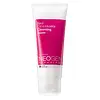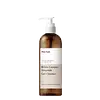What's inside
What's inside
 Key Ingredients
Key Ingredients

 Benefits
Benefits

 Concerns
Concerns

 Ingredients Side-by-side
Ingredients Side-by-side

Water
Skin ConditioningGlycerin
HumectantPotassium Cocoyl Glycinate
Cocamidopropyl Betaine
CleansingHydroxypropyl Starch Phosphate
Sodium Chloride
MaskingLauric Acid
CleansingCitrus Aurantium Bergamia Fruit Oil
MaskingGluconolactone
Skin ConditioningLactobionic Acid
BufferingAsiaticoside
AntioxidantAsiatic Acid
Skin ConditioningMadecassic Acid
Skin ConditioningOctyldodecanol
EmollientCeramide NP
Skin ConditioningHydrogenated Lecithin
EmulsifyingCaprylic/Capric Triglyceride
MaskingHyaluronic Acid
HumectantCentella Asiatica Extract
CleansingMadecassoside
AntioxidantHydrolyzed Hyaluronic Acid
HumectantSodium Hyaluronate
HumectantPanthenol
Skin ConditioningAllantoin
Skin ConditioningSodium Benzoate
MaskingCitric Acid
BufferingDisodium Laureth Sulfosuccinate
CleansingButylene Glycol
HumectantEthylhexylglycerin
Skin ConditioningPolyquaternium-7
Disodium EDTA
1,2-Hexanediol
Skin ConditioningWater, Glycerin, Potassium Cocoyl Glycinate, Cocamidopropyl Betaine, Hydroxypropyl Starch Phosphate, Sodium Chloride, Lauric Acid, Citrus Aurantium Bergamia Fruit Oil, Gluconolactone, Lactobionic Acid, Asiaticoside, Asiatic Acid, Madecassic Acid, Octyldodecanol, Ceramide NP, Hydrogenated Lecithin, Caprylic/Capric Triglyceride, Hyaluronic Acid, Centella Asiatica Extract, Madecassoside, Hydrolyzed Hyaluronic Acid, Sodium Hyaluronate, Panthenol, Allantoin, Sodium Benzoate, Citric Acid, Disodium Laureth Sulfosuccinate, Butylene Glycol, Ethylhexylglycerin, Polyquaternium-7, Disodium EDTA, 1,2-Hexanediol
Water
Skin ConditioningSodium C14-16 Olefin Sulfonate
CleansingLauryl Betaine
CleansingGlycerin
HumectantSodium Chloride
MaskingLactobacillus
Skin ConditioningLactobacillus/Soymilk Ferment Filtrate
Skin ConditioningButylene Glycol
HumectantSodium Hyaluronate
HumectantHydroxypropyltrimonium Hyaluronate
Hydrolyzed Hyaluronic Acid
HumectantSodium Acetylated Hyaluronate
HumectantHyaluronic Acid
HumectantSodium Hyaluronate Crosspolymer
HumectantPotassium Hyaluronate
Skin ConditioningHydrogenated Lecithin
EmulsifyingCentella Asiatica Extract
CleansingCamellia Sinensis Leaf Extract
Antimicrobial1,2-Hexanediol
Skin ConditioningRosmarinus Officinalis Leaf Extract
AntimicrobialAllantoin
Skin ConditioningXylitol
HumectantPanax Ginseng Berry Extract
Skin ConditioningSaponaria Officinalis Leaf Extract
AntimicrobialGuar Hydroxypropyltrimonium Chloride
Skin ConditioningMaltodextrin
AbsorbentHexylene Glycol
EmulsifyingPropylene Glycol Laurate
Skin ConditioningCeramide NP
Skin ConditioningBifida Ferment Lysate
Skin ConditioningGlucose
HumectantSodium Bicarbonate
AbrasivePhytosteryl/Octyldodecyl Lauroyl Glutamate
Skin ConditioningPapain
Skin ConditioningXylitylglucoside
HumectantAnhydroxylitol
HumectantFructan
Skin ConditioningEthylhexylglycerin
Skin ConditioningGluconolactone
Skin ConditioningCaprylic/Capric Triglyceride
MaskingSodium Metabisulfite
AntioxidantLevulinic Acid
PerfumingGlycyrrhiza Glabra Root Extract
BleachingChamomilla Recutita Flower Extract
MaskingCaprylyl Glycol
EmollientLaurylpyridinium Chloride
AntimicrobialXanthan Gum
EmulsifyingDisodium EDTA
Polygonum Cuspidatum Root Extract
AntioxidantScutellaria Baicalensis Root Extract
AstringentWater, Sodium C14-16 Olefin Sulfonate, Lauryl Betaine, Glycerin, Sodium Chloride, Lactobacillus, Lactobacillus/Soymilk Ferment Filtrate, Butylene Glycol, Sodium Hyaluronate, Hydroxypropyltrimonium Hyaluronate, Hydrolyzed Hyaluronic Acid, Sodium Acetylated Hyaluronate, Hyaluronic Acid, Sodium Hyaluronate Crosspolymer, Potassium Hyaluronate, Hydrogenated Lecithin, Centella Asiatica Extract, Camellia Sinensis Leaf Extract, 1,2-Hexanediol, Rosmarinus Officinalis Leaf Extract, Allantoin, Xylitol, Panax Ginseng Berry Extract, Saponaria Officinalis Leaf Extract, Guar Hydroxypropyltrimonium Chloride, Maltodextrin, Hexylene Glycol, Propylene Glycol Laurate, Ceramide NP, Bifida Ferment Lysate, Glucose, Sodium Bicarbonate, Phytosteryl/Octyldodecyl Lauroyl Glutamate, Papain, Xylitylglucoside, Anhydroxylitol, Fructan, Ethylhexylglycerin, Gluconolactone, Caprylic/Capric Triglyceride, Sodium Metabisulfite, Levulinic Acid, Glycyrrhiza Glabra Root Extract, Chamomilla Recutita Flower Extract, Caprylyl Glycol, Laurylpyridinium Chloride, Xanthan Gum, Disodium EDTA, Polygonum Cuspidatum Root Extract, Scutellaria Baicalensis Root Extract
Ingredients Explained
These ingredients are found in both products.
Ingredients higher up in an ingredient list are typically present in a larger amount.
1,2-Hexanediol is a synthetic liquid and another multi-functional powerhouse.
It is a:
- Humectant, drawing moisture into the skin
- Emollient, helping to soften skin
- Solvent, dispersing and stabilizing formulas
- Preservative booster, enhancing the antimicrobial activity of other preservatives
Allantoin is a soothing ingredient known for its protective and moisturizingg properties. Because of this, it is often added to products with strong active ingredients.
Studies show higher concentrations of this ingredient can promote wound healing.
Though it can be derived from the comfrey plant, allantoin is produced synthetically for cosmetic products to ensure purity.
Learn more about AllantoinButylene Glycol (or BG) is used within cosmetic products for a few different reasons:
Overall, Butylene Glycol is a safe and well-rounded ingredient that works well with other ingredients.
Though this ingredient works well with most skin types, some people with sensitive skin may experience a reaction such as allergic rashes, closed comedones, or itchiness.
Learn more about Butylene GlycolThis ingredient is an emollient, solvent, and texture enhancer. It is considered a skin-softener by helping the skin prevent moisture loss.
It helps thicken a product's formula and makes it easier to spread by dissolving clumping compounds.
Caprylic Triglyceride is made by combining glycerin with coconut oil, forming a clear liquid.
While there is an assumption Caprylic Triglyceride can clog pores due to it being derived from coconut oil, there is no research supporting this.
Learn more about Caprylic/Capric TriglycerideCentella Asiatica Extract (Centella) is derived from an herb native to Southeast Asia. It is famous for its anti-inflammatory and soothing properties.
Centella is rich in antioxidants and amino acids, such as Madecassic Acid and Asiaticoside.
Studies show the compounds in centella help with:
The combination of all these properties makes centella effective at soothing, hydrating, and protecting the skin.
Other great components of centella include Vitamin A, vitamin C, several B vitamins, and Asiatic Acid.
Fun fact: Centella has been used as a medicine and in food for many centuries. As a medicine, it is used to treat burns, scratches, and wounds.
Learn more about Centella Asiatica ExtractCeramide NP is a type of ceramide and formally known as ceramide 3.
Ceramides are intercellular lipids naturally found in our skin that bonds dead skin cells together to create a barrier. They are known for their ability to hold water and thus are a great ingredient for dry skin.
Ceramides are an important building block for our skin barrier. A stronger barrier helps the skin look more firm and hydrated. By bolstering the skin ceramides act as a barrier against irritating ingredients. This can help with inflammation as well.
If you would like to eat ceramides, sweet potatoes contain a small amount.
Read more about other common types of ceramides here:
Ceramide AP
Ceramide EOP
Disodium EDTA plays a role in making products more stable by aiding other preservatives.
It is a chelating agent, meaning it neutralizes metal ions that may be found in a product.
Disodium EDTA is a salt of edetic acid and is found to be safe in cosmetic ingredients.
Learn more about Disodium EDTAEthylhexylglycerin (we can't pronounce this either) is commonly used as a preservative and skin softener. It is derived from glyceryl.
You might see Ethylhexylglycerin often paired with other preservatives such as phenoxyethanol. Ethylhexylglycerin has been found to increase the effectiveness of these other preservatives.
Gluconolactone is a PHA. PHAs are a great gentle alternative to traditional AHAs.
When applied, Gluconolactone has the same affect on skin as AHAs such as lactic acid. It helps dissolve the dead skin cells in the top layer of your skin. This improves texture and brightens the skin.
PHAs are more gentle than AHAs due to their larger structure. They do not penetrate as deeply as AHAs and take a longer time to dissolve dead cells. Studies show PHAs do not cause as much irritation.
Gluconolactone has some interesting properties:
In a 2004 study, Gluconolactone was found to prevent UV damage in mouse skin cells and has not been found to increase sun sensitivity. However, we still recommend wearing SPF daily.
This ingredient is is an created by reacting gluconic acid with an alcohol.
Learn more about GluconolactoneGlycerin is already naturally found in your skin. It helps moisturize and protect your skin.
A study from 2016 found glycerin to be more effective as a humectant than AHAs and hyaluronic acid.
As a humectant, it helps the skin stay hydrated by pulling moisture to your skin. The low molecular weight of glycerin allows it to pull moisture into the deeper layers of your skin.
Hydrated skin improves your skin barrier; Your skin barrier helps protect against irritants and bacteria.
Glycerin has also been found to have antimicrobial and antiviral properties. Due to these properties, glycerin is often used in wound and burn treatments.
In cosmetics, glycerin is usually derived from plants such as soybean or palm. However, it can also be sourced from animals, such as tallow or animal fat.
This ingredient is organic, colorless, odorless, and non-toxic.
Glycerin is the name for this ingredient in American English. British English uses Glycerol/Glycerine.
Learn more about GlycerinHyaluronic acid is naturally found in healthy skin. It is a humectant, meaning it draws moisture to your skin.
This ingredient helps hydrate, soothe, and protect the skin.
What makes hyaluronic acid so hydrating? It has the capacity to bind or hold large amounts of water.
Fun fact: It is already naturally found in our bodies, such as the fluids of our eyes and our joints.
Studies find this ingredient to have anti-inflammatory and anti-microbial properties. This can help speed up wound-healing.
Hyaluronic acid can be irritating if the molecule has a low-molecular weight, or if the molecules are small.
One study found low-molecular weight hyaluronic acid to be pro-inflammatory, meaning some people may experience irritation. This is because our bodies use hyaluronic acid in the wound-healing process to signal to our bodies, via irritation, that something needs healing.
The same study found high-molecular weight hyaluronic acid to be anti-inflammatory.
These are some other common types of Hyaluronic Acid:
Learn more about Hyaluronic AcidHydrogenated Lecithin is created from the hydrogenation of lecithin (a group of phospholipids). Hydrogenation is a chemical reaction between hydrogen and another element.
This ingredient is an emollient and emulsifier. As an emollient, it helps soften skin by trapping moisture within. As an emulsifier, it prevents oil and water ingredients from separating.
Hydrolyzed Hyaluronic Acid is a form of hyaluronic acid. It is created by the hydrolysis of hyaluronic acid with a high molecular weight. Once created, Hydrolyzed Hyaluronic Acid has a low molecular weight.
Low molecular weight HA has been shown to hydrate and increase elasticity of the skin. Increasing elasticity is also associated with reduction of wrinkle depth.
One study found topical low molecular weight hyaluronic acid may be considered for the treatment of rosacea in the adult population. However, we always recommend speaking with a professional about your skin concerns.
Hyaluronic acids are a humectant. This means they draw moisture from the air. Hyaluronic acids help moisturize, soothe, and protect the skin.
Read more about other common forms of hyaluronic acid:
Learn more about Hydrolyzed Hyaluronic AcidChances are, you eat sodium chloride every day. Sodium Chloride is also known as table salt.
This ingredient has many purposes in skincare: thickener, emulsifier, and exfoliator.
You'll most likely find this ingredient in cleansers where it is used to create a gel-like texture. As an emulsifier, it also prevents ingredients from separating.
There is much debate on whether this ingredient is comedogenic. The short answer - comedogenic ratings don't tell the whole story. Learn more about comegodenic ratings here.
The concensus about this ingredient causing acne seems to be divided. Research is needed to understand if this ingredient does cause acne.
Scrubs may use salt as the primary exfoliating ingredient.
Learn more about Sodium ChlorideSodium Hyaluronate is hyaluronic acid's salt form. It is commonly derived from the sodium salt of hyaluronic acid.
Like hyaluronic acid, it is great at holding water and acts as a humectant. This makes it a great skin hydrating ingredient.
Sodium Hyaluronate is naturally occurring in our bodies and is mostly found in eye fluid and joints.
These are some other common types of Hyaluronic Acid:
Learn more about Sodium HyaluronateWater. It's the most common cosmetic ingredient of all. You'll usually see it at the top of ingredient lists, meaning that it makes up the largest part of the product.
So why is it so popular? Water most often acts as a solvent - this means that it helps dissolve other ingredients into the formulation.
You'll also recognize water as that liquid we all need to stay alive. If you see this, drink a glass of water. Stay hydrated!
Learn more about Water